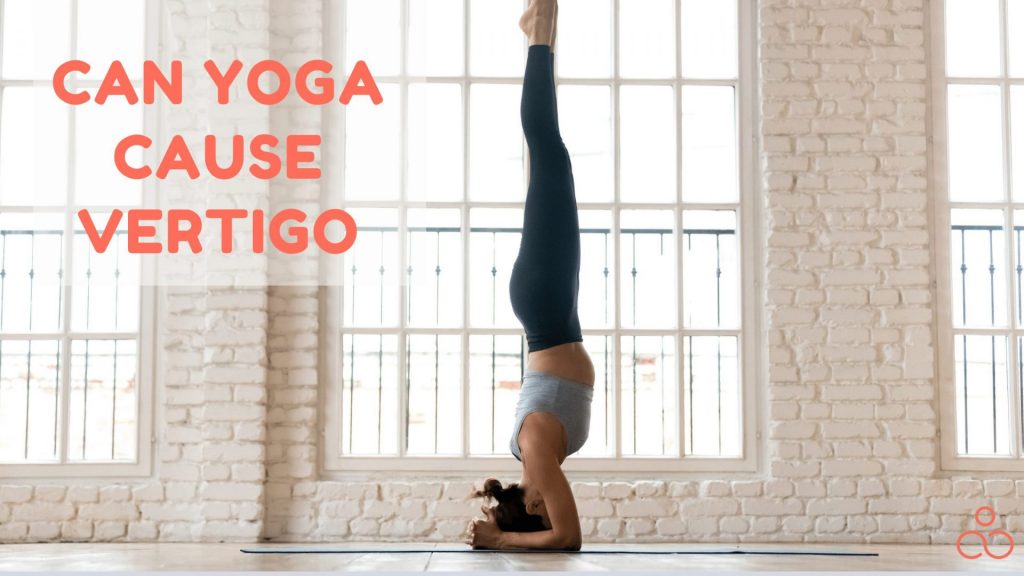Are you getting dizzy on your Yoga mat? No need to worry!
Yoga-induced dizziness can be a real thing. Many Yoga practitioners also experience dizziness or the feeling that the room is spinning uncontrollably.
This article explains what BPPV is, how can Yoga cause vertigo, and how it can be triggered and prevented by specific Yoga postures.
Hope you get what you’re looking for through this article.
What is BPPV and Vertigo? Explore The Connection Between Yoga and Vertigo
Benign paroxysmal positional vertigo (BPPV) is one of the leading causes of vertigo and dizziness, characterized by brief and intense episodes of vertigo, usually lasting seconds and accompanied by episodes of horizontal rotatory nystagmus. It is caused by small calcium crystals in the inner ear that can become dislodged and move into the semicircular canals responsible for detecting head movement and maintaining balance.
Vertigo is specifically induced by sudden changes in the position of the head, such as rolling over in bed, bending over, or looking up. Benign paroxysmal positional vertigo leads to significant morbidity, depression, rising medical costs, and a decline in the quality of life.
Some other causes of vertigo include:
- Inner ear lacking blood flow.
- Vestibular neuritis: inflammation due to viral infections.
- Skull injury causing vertigo, nausea, and hearing loss.
- Allergies triggering vertigo.
- Nerve-affecting diseases like syphilis, tumors, and multiple sclerosis.
- Meniere’s disorder: fluid buildup causing pressure change.
- Ear Balance Disorder in people over 65, leading to dizziness and unsteadiness.
- Cervical spondylitis and sinusitis in the elderly cause vertigo.
- Low blood pressure symptoms: dizziness, nausea, weakness, fainting.
- Postural defects and jerky movements cause vertigo.
Yoga is an effective treatment for BPPV and vertigo. The practice of Yoga can improve balance and coordination, which can reduce the frequency and severity of vertigo episodes. Additionally, certain Yoga poses can help to stimulate the inner ear and improve circulation, which can help to reduce the symptoms of BPPV.
However, despite its advantages, certain risky yoga positions can lead to discomfort or even muscle and joint injuries. For example, head-down poses can dangerously increase intraocular pressure for glaucoma patients.
A 2017 study discovered that people who practiced yoga had a much higher occurrence of BPPV than those in the control group.
A 2019 case report revealed that Benign paroxysmal positional vertigo (BPPV) was the leading vestibular disorder in head trauma patients. The authors documented a case where right horizontal canal BPPV occurred following a yoga session.
Discover How Can Yoga Cause Vertigo & Which 3 Yoga Poses To Avoid
Can Some Yoga poses cause vertigo? The answer is Yes. If you are now wondering which Yoga positions are the culprits, the inverted and upward positions are the most dangerous ones.
So, if you want to stay balanced and keep a clear head, avoid these three Yoga postures:
(1) Headstand (Sirsasana)
Most people do not like to turn their bodies upside down, as this can cause a variety of strange sensations. When you first try this pose, you may feel the blood rush to your head, which can cause dizziness.
If you leave the pose too quickly, the blood will flow rapidly from your head to your lower extremities, which can cause a sudden rush that makes you feel uncomfortable. To ensure you do not feel uncomfortable, exit this position slowly.
(2) Upward Bow Pose (Urdhva Dhanurasana)
In this position, your head is below the head, which can also cause dizziness. All the inverted postures can increase your blood pressure. Therefore, consult a doctor before performing inverted Yoga postures to avoid sudden dizziness and vertigo.
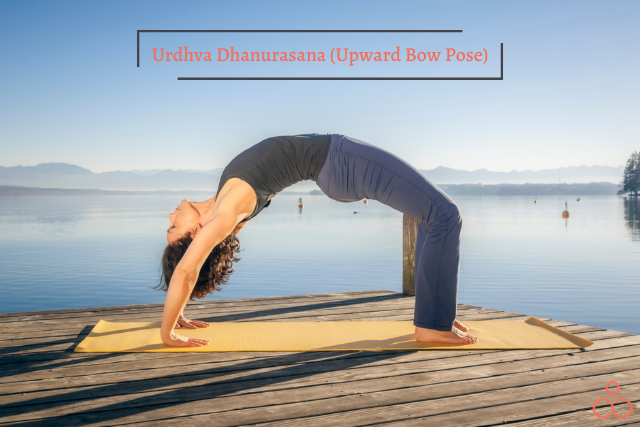
(3) Standing Forward Bend (Uttanasana)
This is one of the most relaxing and rejuvenating Yoga postures. However, if you leave this position too quickly, you will likely feel weak quickly. If you rise too quickly from the forward bend, the blood can flow very quickly to your legs, leaving your heart with very little blood.
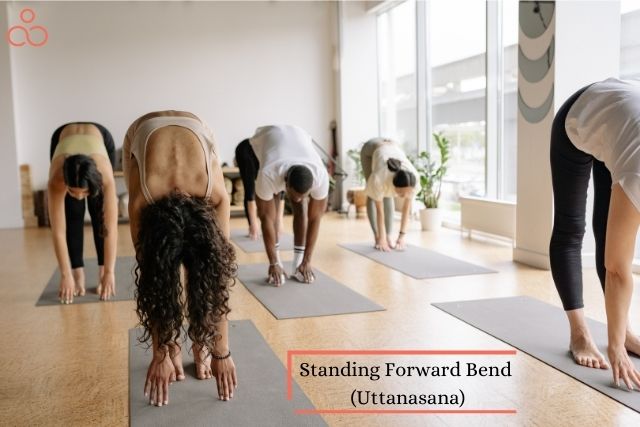
9 Recommended Yoga Asanas, Pranayamas, and Other Techniques for a Vertigo-Free Life
Balasana (The Posture of the Child)
This invigorating posture is a great way to relax and relieve your nervous system. This soothing pose can help you calm down if you suffer from dizziness. If you do this asana regularly, you can even build a stronger nervous system.
Instructions To Follow:
- Kneel on the mat and rest your hips on your feet.
- Maintain an upright posture and slowly lean forward until your upper body touches your knees.
- Try to bring your head as close to the floor as possible.
- Place your hands on your sides with the palms facing up.
- Stay in this position for a few moments before returning to the initial posture.
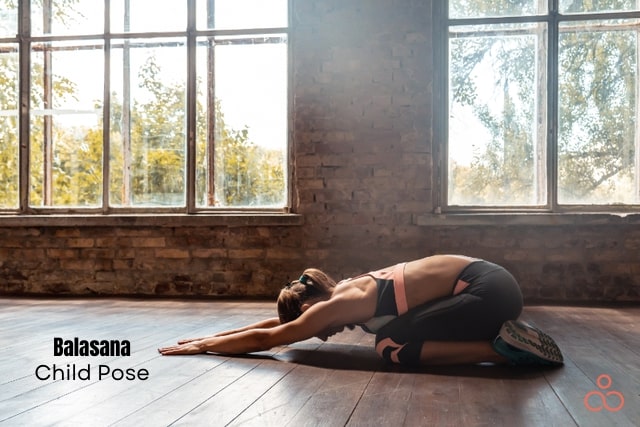
Adhomukha Svanasana (Downward-Facing Dog Pose)
This Yoga pose helps to reduce the strain on the inner ear and promotes blood circulation to the head area.
Instructions To Follow:
- Get into a kneeling position on the mat with your knees slightly apart.
- Place your hands on the mat in line with your shoulders.
- Press your palms into the floor, keep your elbows straight, and lift your hips while keeping your knees straight.
- Stay in this posture for a while and then gradually return to the starting position.
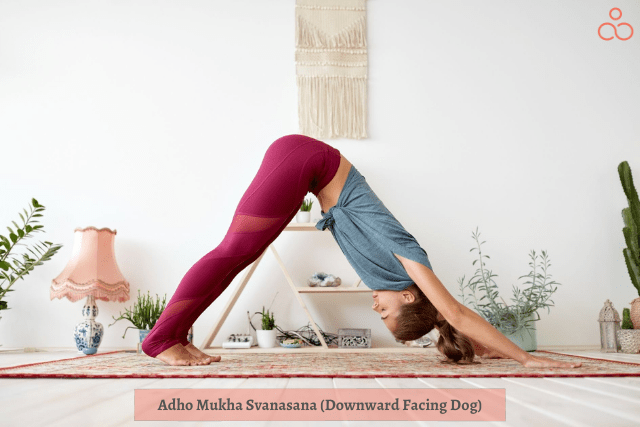
Paschimottanasana (Seated Forward Fold Pose)
This asana boosts circulation to the head, fortifies the nervous system, and reduces tension.
Instructions To Follow:
- Sit with your legs straight and your hands at your sides.
- Bend your arms at the elbows with the palms facing down.
- Lean back and bend your body forward as you exhale.
- Reach for your toes or hold your feet.
- Gently lower your head as far as possible.
- Stay in this posture for a few moments as you continue to breathe.
- When you inhale, return to the starting position.
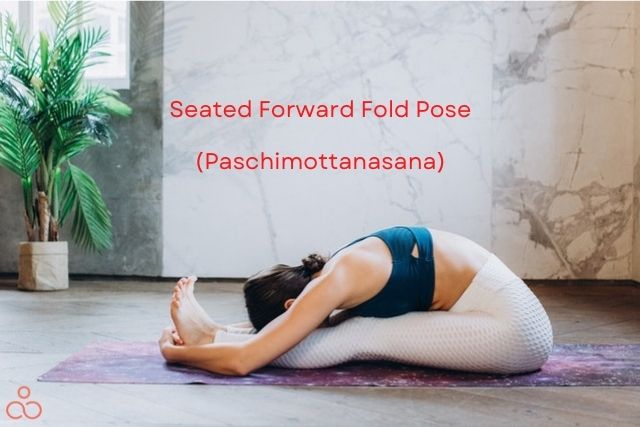
Viparita Karani (The Inverted Posture)
People with vertigo can reap the rewards of this unique method of turning upside down; it can bring peace to the mind and ease the pain of headaches. Plus, it boosts the blood supply to the head and helps to relax the body.
Instructions To Follow:
- Recline comfortably on your back and rest your arms by your sides.
- Take the time to lift your legs off the floor with the help of your hands.
- Remain still in this position and hold your body with your hands behind your back to keep your balance.
- Breathe normally and stay in this position for a few minutes, depending on how comfortable you feel.
- Gently lower your hips with the help of your hands.
- If you include the wall in your exercise, you can use it as a prop to support your legs during this Yoga pose.
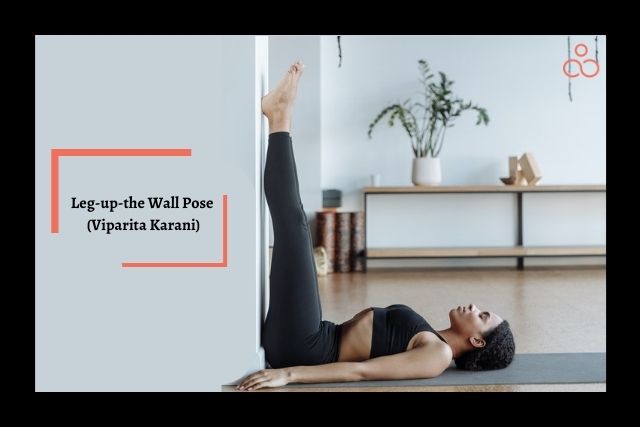
Supta Bhadrasana (The Auspicious Posture “supine”)
This Yoga posture is beneficial in restoring the flow of blood and decreasing dizziness by soothing the brain.
Instructions To Follow:
- Lean back and place your feet together in the Namaste posture.
- Place your palms on your thighs.
- Breathe naturally and hold this posture for a few seconds.
- When you have finished, pause and relax.
Makarasana (The Crocodile Posture)
This calming posture helps ease muscular and mental pressure while sharpening concentration and focus.
Instructions To Follow:
- Lie on your stomach and use your hands as a pillow.
- Stretch out your legs with your toes pointing inwards and your heels slightly apart.
- Lie still and shift all your weight to the floor.
- Close your eyes and breathe in a relaxed manner.
- Stay in this posture for a few minutes.
- Gently open your eyes, briefly roll onto your right side, and straighten into a sitting position.
Shavasana (The Corpse Posture)
This pose offers a complete sense of tranquillity, helping to reduce any feelings of dizziness immediately.
Instructions To Follow:
- Lie on your back with your hands slightly away from your body and palms facing upwards.
- Breathe slowly and naturally without moving any parts of your body.
- Take time to focus on the 16 vital areas (Marmasthana) of the body – toes, ankles, knees, thighs, hands and arms, groin, pelvis, navel, abdomen, chest, neck, lips, the tip of the nose, eyes, space between the eyebrows, forehead, and crown of the head.
- Relax in this position for 10 to 15 minutes and breathe normally.
- When you are ready, open your eyes, turn to your right side for a few minutes, and slowly move to a sitting position, leaning on your hands.
Yoni Mudra
This method relaxes the nervous system and revitalizes the eyes, ears, and other facial areas.
Instructions To Follow:
- Sit in a comfortable meditative position, such as Padmasana.
- Gently close the eyes and place the thumbs on the ears while the index fingers gently rest on the eyelashes.
- Place the middle fingers on the nostrils, the ring fingers over the lips, and the little fingers under the lips.
- Keep your elbows parallel to the floor, at shoulder level.
- Just observe your breathing without trying to control it.
- If your thoughts wander, please bring them back to your breath.
- Practising Yoni Mudra for 5-10 minutes daily for the best results is recommended.
Kapal Bhati (The Radiant Face)
This practice invigorates fatigued nerves, promotes better blood flow, and supplies oxygen to the entirety of the face.
Instructions To Follow:
- Sit in the meditative position you find comfortable.
- Breathe in and out sharply, forcefully, and quickly.
- Refrain from inflating your nostrils, and be sure to do minimal physical activity. The muscles of the larynx are activated unconsciously.
- Take ten of these short, quick breaths to make one round. Do 3 to 5 rounds at a time.
To know more about Pranayama and how it works, feel free to explore our informative article here.
The Benefits of These 9 Yoga Poses for BPPV Management
- Reduces stress: Yoga helps in the reduction of stress and anxiety, which can potentially alleviate BPPV symptoms.
- Improves balance: Regular yoga practice enhances balance and body awareness, which can help reduce the frequency and intensity of BPPV episodes.
- Increases flexibility: Yoga enhances flexibility in the neck and spine, potentially improving the head movement range and reducing the triggering of vertigo symptoms.
- Strengthens core muscles: Strengthening core muscles through yoga provides better support to the spine, resulting in better posture and reduced risk of BPPV symptoms.
- Promotes relaxation: Deep breathing exercises and meditation in yoga induce a relaxation response, helping to manage stress and anxiety related to BPPV.
- Boosts overall vestibular health: Practicing specific yoga poses targeting the inner ear improves vestibular function, making it easier for people with BPPV to cope with their condition.
- Enhances focus and concentration: Mindfulness exercises in yoga can lead to increased focus and mental clarity, helping individuals with BPPV better manage their symptoms.
- Supports recovery: Regular yoga practice can aid in faster recovery from a BPPV episode by promoting relaxation, improving circulation, and supporting overall well-being.
Do’s and Don’ts of Yoga To Avoid Symptoms of Vertigo
| Parameters | Do | Don’t |
| Breathing | Maintain steady and slow breaths | Holding your breath during poses |
| Focus | Keep your focus on a fixed point | Changing your gaze abruptly |
| Proper Space | Practice in a well-ventilated space | Practicing in a crowded or cluttered space |
| Presence of Balance | Use props for support and stability | Overexerting yourself or pushing too hard in challenging poses |
| Food Intake | Stay well-hydrated | Practicing on an empty stomach or immediately after a meal |
| Suitable head position | Choose poses that keep your head above your heart | Inversions or any poses where the head is below the heart |
| Movement | Move slowly and mindfully between poses | Quick movements and transitions |
| Body signs | Listen to your body’s signals | Ignoring signs of discomfort, dizziness, or imbalance. |
Some Recommended Useful Key Points To Prevent Vertigo For Women
Vertigo can be a debilitating condition, and if you often suffer from dizziness during your menstrual cycle, here are some great ways to limit or prevent it:
Stay hydrated
Dehydration can exacerbate vertigo symptoms, so drink plenty of water throughout the day. Not drinking enough water can lead to blood pressure problems and make it difficult to perform the poses.
Avoid caffeine and alcohol
These substances can worsen vertigo symptoms, so avoiding them or limiting your intake is best.
Practice good sleep hygiene
Getting enough sleep and maintaining a regular sleep schedule can help prevent vertigo.
Avoid sudden movements
Do not rush out of the inversion poses and rest in the child’s pose. Take it slow when moving into more challenging poses, and do not be afraid to take your time when exiting inverted poses or forward bends. Sudden movements can trigger vertigo, so try to move slowly and steadily.
Practice relaxation techniques
Stress can exacerbate vertigo symptoms, so try practicing relaxation techniques like deep breathing or meditation to help manage your stress levels.
Exercise regularly
Regular exercise can improve balance and reduce the risk of vertigo.
Manage stress
Stress can trigger vertigo symptoms, so find ways to manage stress in your daily life.
Consider physical therapy
Physical therapy can help improve balance and reduce vertigo symptoms through targeted exercises and techniques.
Talk to your doctor
If you’re experiencing vertigo symptoms, consult your doctor to determine the underlying cause and develop an appropriate treatment plan.
Remember that Yoga is not a race
Always remember that there is no need to rush. Even if you are taking a class, your teacher’s instructions are only suggestions and should never be taken as a command.
By following these key points, women can reduce their risk of experiencing vertigo and improve their overall quality of life. It is essential to always listen to your body and make modifications as necessary. If you continue to experience dizziness during your Yoga practice, consult with a healthcare professional to rule out any underlying medical conditions.
FAQ’s
Can Yoga cause positional vertigo?
Yes, Yoga can cause positional vertigo. Certain Yoga poses can cause the inner ear fluid to move, leading to dizziness and vertigo. However, this happens rarely and can usually be avoided by practicing Yoga under the guidance of a trained instructor and avoiding poses that may trigger vertigo.
What is the permanent cure for positional vertigo?
The permanent cure for positional vertigo varies depending on the cause of your dizziness. There is no known permanent cure for positional vertigo, but there are treatments that can help alleviate symptoms.
Some common treatments may include physical therapy, medication, chiropractic care, lifestyle changes, or even a simple head exercise known as the Epley maneuver. It is best to consult with a doctor for proper diagnosis and treatment of any medical condition.
Which exercise is best for BPPV?
The Home Epley maneuver is an effective exercise for controlling the symptoms of benign paroxysmal positional vertigo (BPPV). You can perform this exercise from the comfort of your own home.
How should I sleep to avoid BPPV?
Many experts recommend sleeping on your back to avoid disturbing the crystals in your ear canals to reduce the risk of a dizzy spell.
Can exercise trigger BPPV?
BPPV triggered by strenuous exercise is rare (9/430) and could be caused by recurrent minimal vertical vibration accelerations associated with metabolic changes during strenuous exercise.
Conclusion
Yes, Yoga can indeed be a possible cause of vertigo if you are not careful in your approach. However, its power to induce dizziness actually stems from the fact that there are certain poses and practices which have the potential to cure many forms of vertigo, most notably Benign Paroxysmal Positional Vertigo (BPPV). Therefore, if you suffer from any form of vertigo or dizziness, try some simple Yoga poses, as these could prove an excellent remedy for your condition.
Remember to check with your doctor before trying new types of exercise or physical activity, as this will ensure you stay safe throughout the practice.

